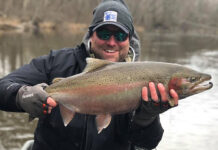
Having now reached the point of achieving adequate creature comforts for members of the pioneer family with the creation of the barnhouse, it was time to work on creature comforts for the livestock on the embryonic farmstead.
Up until now, the farm’s animals had been what folks today call “free range.” That is to say, the livestock had been fairly free to roam the woods, for the most part browsing on whatever food might be found, supplemented with some regular feed as well. The animals’ wanderings were generally overseen by the family’s dog, which was tasked with protecting them from marauding wolves, bears, coyotes, foxes and other predators.
The dogs back then were typically large mastiff-type animals, as formidable as the predators they confronted. Their allegiance to their owners likely was earned only by a regimen of regular meals which they would return to the homestead for. It is likely that the owners of these dogs were almost as scared of them as they were of the wild animals that lurked just beyond the feeble clearings they had thus far made in the woods.
These dogs typically wore heavy leather collars which were fitted all around with formidable 2-inch-long pointed iron spikes. These were necessary because the predators that attacked them would immediately go for the dog’s throat. The spiked collars were designed to deter them from doing that.

Stump fence
At any rate, the time had come to construct some barnyard fencing to confine the livestock and be better able to protect them, since the family’s economic survival largely depended on the foods they produced.
The most available type of fencing was that which could be readily fabricated from materials at hand — tree trunks that had been pulled from the ground and large branches that had been removed from the trunks of trees that were being converted into building material.
Horses were used to pull the stumps and branches into a line to form a barrier. The sharp, dried tree roots were somewhat of a deterrent to invading wild animals, and similarly worked to discourage the livestock from pushing through them. A stump fence like this could last and be effective for several years, although it could readily be added to as more trees were felled to create farmland and their stumps were pulled.
Split rail fence
Another kind of fencing — probably that employed most often — was the split rail fence. Still popular today, this type of fencing consists of vertical posts with two or three oblong holes cut into them, with the posts typically being set about 10 feet apart. Into the holes are placed horizontal rails, split from tree trunks. While cutting trees for cabin logs, the settler kept an eye out for nice straight tree trunks that could be split into fence rails as well and set them aside for that eventual purpose.
The most durable logs for making the posts which would be set into the ground were chestnut, honey locust and white oak. It is said that a honey locust post would last up to 25 years, but splitting it was a formidable job.
Crafting the fence posts after they had been split out and cut to a length of about 8 feet was a tedious task at best. To make the rectangular or oval holes into which the cross rails would be inserted, the crafter would use a T-handled auger. He drilled a series of holes through the post, close together until he bored the successive holes the length of the desired opening. He then used a special axe called a mortising axe (often referred to as a “fence post axe”) to chisel out the flanges of wood left between the bored holes. When he had finished creating the trio of desired openings in the post, he charred the end of the post opposite the newly created openings in a fire. The charring essentially cauterized the fibers in the end grain of the wood, discouraging both moisture and insects from entering. The post was then put into a post hole in the ground with gravel packed around it to prevent soil and water from being held against it and rotting it.

The next job was to split the cross rails, which required a different set of tools. Logs for the rails were usually 12 to 14 feet in length, measured by a 2-foot rule which was scratched into the handle of the axe. The rail splitter began his split by using a heavy maul to drive an iron wedge into a crack at the end of the log, formed by its drying out. This would begin to separate the grain for a couple of feet. He would then extend this crack to the opposite end of the log by inserting numerous wooden wedges called “gluts” along its length, driving them in successively until the log split in half. Dogwood and gum wood were exceptionally tough and made the most durable gluts, although the addition of a wrought iron ring around the top of any glut would extend its life significantly.

The railmaker would then split and re-split the halves to make triangular-shaped rails 3 to 4 inches thick. Because the split followed the grain of the wood many of these rails were crooked or twisted. A good splitter could produce about 75 rails a day, depending on the hardness of the wood he was working with. Bunches of rails were then dragged to the fencing site by wrapping a chain around them and hitching a horse or ox to the bundle.
Zig-zag fence
A third type of fencing went by the various names of “zig-zag fencing,” “snake rail fencing,” “worm fencing” and “stake and rider” fencing. In this technique, the rails zig-zagged back and forth within a strip 6- to 8-feet wide. The ends of the rails closest to the ground rested on stones to slow down rot. Where the stacks of rails intersected, they were braced by two short poles slanted toward one another to stabilize the “Vs” where the sets of rails crossed one another.
All of this fencing not only helped in confining livestock, but it defined organizational boundaries within the growing farmstead that would further determine the overall layout as it evolved.












